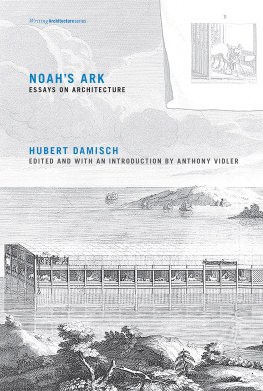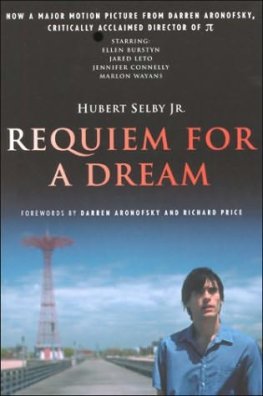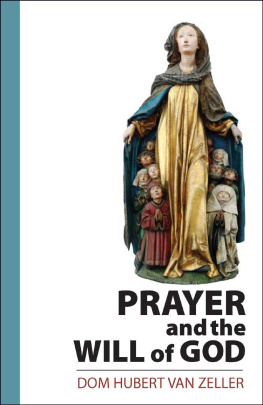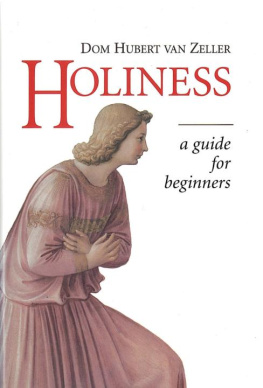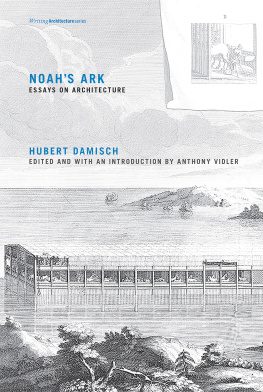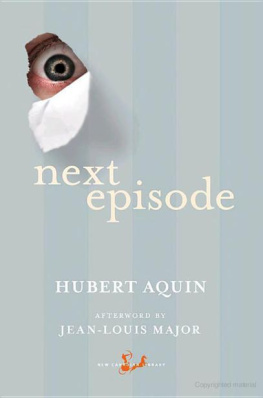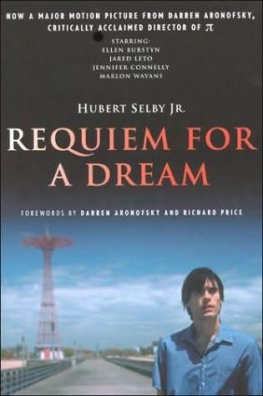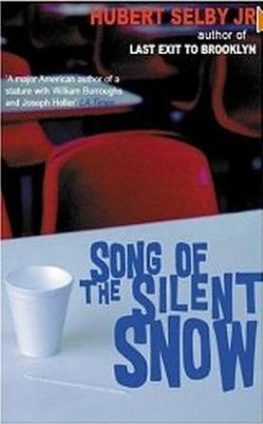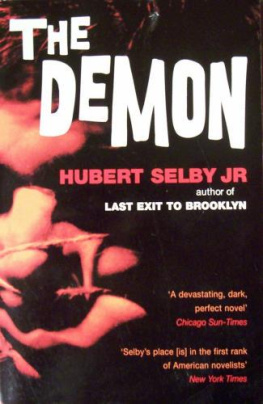Damisch Hubert - Noahs Ark
Here you can read online Damisch Hubert - Noahs Ark full text of the book (entire story) in english for free. Download pdf and epub, get meaning, cover and reviews about this ebook. year: 2016, publisher: MIT Press, genre: Romance novel. Description of the work, (preface) as well as reviews are available. Best literature library LitArk.com created for fans of good reading and offers a wide selection of genres:
Romance novel
Science fiction
Adventure
Detective
Science
History
Home and family
Prose
Art
Politics
Computer
Non-fiction
Religion
Business
Children
Humor
Choose a favorite category and find really read worthwhile books. Enjoy immersion in the world of imagination, feel the emotions of the characters or learn something new for yourself, make an fascinating discovery.
- Book:Noahs Ark
- Author:
- Publisher:MIT Press
- Genre:
- Year:2016
- Rating:4 / 5
- Favourites:Add to favourites
- Your mark:
- 80
- 1
- 2
- 3
- 4
- 5
Noahs Ark: summary, description and annotation
We offer to read an annotation, description, summary or preface (depends on what the author of the book "Noahs Ark" wrote himself). If you haven't found the necessary information about the book — write in the comments, we will try to find it.
Noahs Ark — read online for free the complete book (whole text) full work
Below is the text of the book, divided by pages. System saving the place of the last page read, allows you to conveniently read the book "Noahs Ark" online for free, without having to search again every time where you left off. Put a bookmark, and you can go to the page where you finished reading at any time.
Font size:
Interval:
Bookmark:
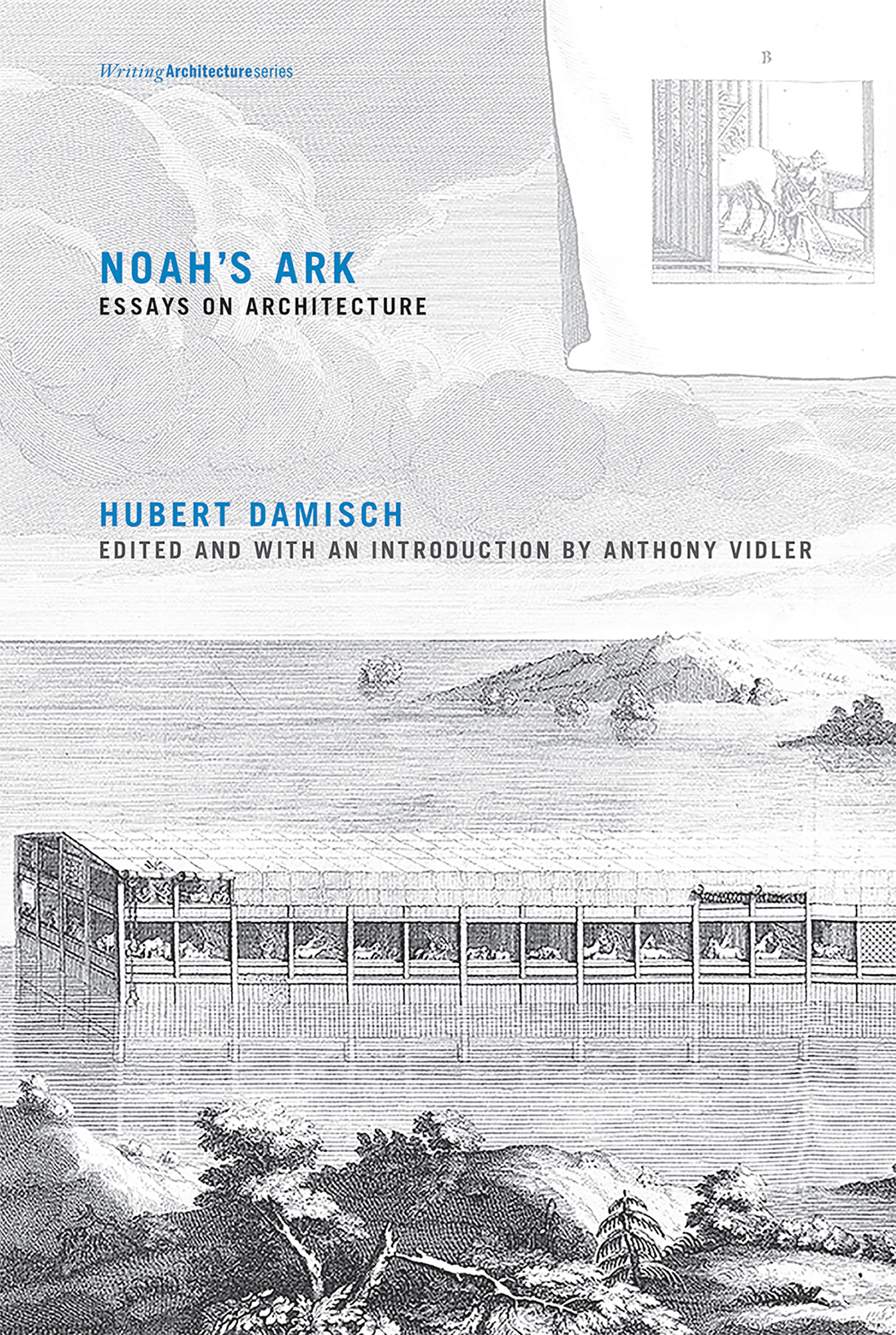
Noahs Ark
Writing Architecture series
A project of the Anyone Corporation; Cynthia Davidson, editor
Earth Moves: The Furnishing of Territories Bernard Cache, 1995
Architecture as Metaphor: Language, Number, Money Kojin Karatani, 1995
Differences: Topographies of Contemporary Architecture Ignasi de Sol-Morales, 1996
Constructions John Rajchman, 1997
Such Places as Memory John Hejduk, 1998
Welcome to the Hotel Architecture Roger Connah, 1998
Fire and Memory: On Architecture and Energy Luis Fernndez-Galiano, 2000
A Landscape of Events Paul Virilio, 2000
Architecture from the Outside: Essays on Virtual and Real Space Elizabeth Grosz, 2001
Public Intimacy: Architecture and the Visu a l Arts Giuliana Bruno, 2007
Strange Details Michael Cadwell, 2007
Histories of the Immediate Present: Inventing Architectural Modernism Anthony Vidler, 2008
Drawing for Architecture Leon Krier, 2009
Architectures Desire: Reading the Late Avant-Garde K. Michael Hays, 2009
The Possibility of an Absolute Architecture Pier Vittorio Aureli, 2011
The Alphabet and the Algorithm Mario Carpo, 2011
Oblique Drawing Massimo Scolari, 2012
A Topology of Everyday Constellations Georges Teyssot, 2013
Project of Crisis: Manfredo Tafuri and Contemporary Architecture Marco Biraghi, 2013
A Question of Qualities: Essays in Architecture Jeffrey Kipnis, 2013
Noahs Ark: Essays on Architecture Hubert Damisch, 2016
Noahs Ark
Essays on Architecture
Hubert Damisch
Edited and with an introduction by Anthony Vidler
Translated by Julie Rose
The MIT Press
Cambridge, Massachusetts
London, England
2016 Massachusetts Institute of Technology
This translation was made possible in part by a grant from the Graham Foundation for Advanced Studies in the Fine Arts.
All rights reserved. No part of this book may be reproduced in any form by any electronic or mechanical means (including photocopying, recording, or information storage and retrieval) without permission in writing from the publisher.
Library of Congress Cataloging-in-Publication Data
Names: Damisch, Hubert, author. | Vidler, Anthony, editor. | Rose, Julie,
1952 translator.
Title: Noahs ark : essays on architecture / Hubert Damisch ; Edited and
introduction by Anthony Vidler ; Translated by Julie Rose.
Description: Cambridge, MA : The MIT Press, 2016. | Series: Writing
architecture | Includes bibliographical references and index.
Identifiers: LCCN 2015038269 | ISBN 9780262528580 (pbk. : alk. paper)
Subjects: LCSH: ArchitecturePhilosophy.
Classification: LCC NA2500 .D33513 2016 | DDC 720.1dc23 LC record available at http://lccn.loc.gov/2015038269
EPUB Version 1.0
In memory of
JOSEPH ZALEWSKI
(19071979)
Professor in the School of Architecture
at Harvard University
CONTENTS
Sources
The essays collected here are sometimes partly rewritten, oftentimes translated (sometimes anew) by the award-winning translator Julie Rose, and edited by Anthony Vidler. The prologue first appeared as LArche de No inRevue Critique 43 (JanuaryFebruary 1987). Chapter 1, Aujourdhui, larchitecture, first appeared as inLe temps de la rflexion, no. 2 (1981). Chapter 2, The Column, the Wall, was published in French and English inArchitectural Design 49 (1979), in a special issue on Leon Battista Alberti edited by Joseph Rykwert. Chapter 4 first appeared as La Colonnade de Perrault et les fonctions de lordre classique inLurbanisme de Paris et lEurope, 16001680, edited by Pierre Francastel (1969). Chapter 5 was first published as Larchitecture raisonne, the preface toLarchitecture raisonn: Extraits du Dictionnaire de larchitecture franaise (1964). A previous translation appeared inArchitectural Design 50, nos. 34 (1980), a special issue on Viollet-le-Duc. Chapter 6 first appeared as Du structuralisme au fonctionnalisme inA la rescherch de Viollet-le-Duc, edited by Geert Bekaert (1980). Chapter 7, Ledoux with Kant, was originally published as the preface to the French translation of Emil KaufmannsDe Ledoux Le Corbusier: Origine et dveloppement de larchitecture autonome (1981). It was translated by Erin Williams and previously appeared in Perspecta 33, a special issue titled Mining Autonomy (2002). Chapter 8 first appeared as Lautre Ich ou le dsir du vide: Pour un tombeau dAdolf Loos inCritique 31, nos. 339340 (AugustSeptember 1975). The translation here, by John Savage, was published first inGrey Room 1 (Autumn 2000). Chapter 9 first appeared as Ornamento inLEnciclopedia Einaudi, vol. 10 (1980). Chapter 10, Against the Slope: Le Corbusiers La Tourette, first appeared in English, translated by Julie Rose, inLog 4 (Winter 2005). Chapter 11 first appeared as La plus petite difference inMies van der Rohe: Sa carrire, son hritage et ses disciples, an exhibition catalogue published by Centre Georges Pompidou (1987). Chapter 12 appeared as Le parti du dtail inJean Prouv: Constructeur 19011984, published by Centre Georges Pompidou (1990). Chapter 13 is a compilation of four essays that first appeared in theAny book series, published by the Anyone Corporation with the MIT Press: How We Deal with History, inAnyhow (1998); Three Minus Two, Two Plus One: Architecture and the Fabric of Time, inAnytime (1999); The Offense of Wandering, translated by Mortimer Schiff, inAnymore (2000), and Anything But, inAnything (2001). Chapter 14, Blotting Out Architecture? A Fable in Seven Parts, translated by Julie Rose for publication inLog 1 (Fall 2003), was first given as the lecture Effacer larchitecture at the Canadian Centre for Architecture in Montreal in May 2003.
Introduction
I keep thinking of myself as some sort of displaced philosopher. The issue of displacement is, in any sense, crucial to my work. According to Gilles Deleuze, philosophy has mostly to do with inventing concepts. In that sense, I am not a philosopher: I do not invent concepts, but I try to displace them. For instance, the concept of structure is of great interest, when dealt with in artistic terms. I first became interested in architecture because architecture provides us with an open series of structural models.
Hubert Damisch
The following essays, written between 1963 and 2005, represent Hubert Damischs forays into architectural theory. Organized roughly according to the chronology of their subject matter, they span the period between the Renaissance and the present, a period of architectures emergence as a discipline with all the attendant problems of origin (Noahs Ark or Adams House?), structure (abstract model of relations between the elements, or supporting framework?), meaning (communicative sign or silent system?), and, with increasing industrialization, material (building fabric or essential nature?).
These questions and more permeate Damischs reflections, which are not so much couched in terms of theoretical pronouncements or historical exegeses but rather read as what he calls in another preface a set of exercises. In the case of the previous collection, under the titleSkyline, Damischs exercises were primarily (as his subtitleThe Narcissistic City indicates) concerned with the imaginary, symbolic realms explored by psychoanalysis. In the present collection, the preoccupation is less with Freud or Lacan (although the presence of a modern subject is always lurking close to the surface) as it is with the general idea of structure, construed both physically and mentally and analyzed in terms introduced by structuralists both anthropological and linguistic, from Claude Lvi-Strauss to Roland Barthes.
Font size:
Interval:
Bookmark:
Similar books «Noahs Ark»
Look at similar books to Noahs Ark. We have selected literature similar in name and meaning in the hope of providing readers with more options to find new, interesting, not yet read works.
Discussion, reviews of the book Noahs Ark and just readers' own opinions. Leave your comments, write what you think about the work, its meaning or the main characters. Specify what exactly you liked and what you didn't like, and why you think so.

